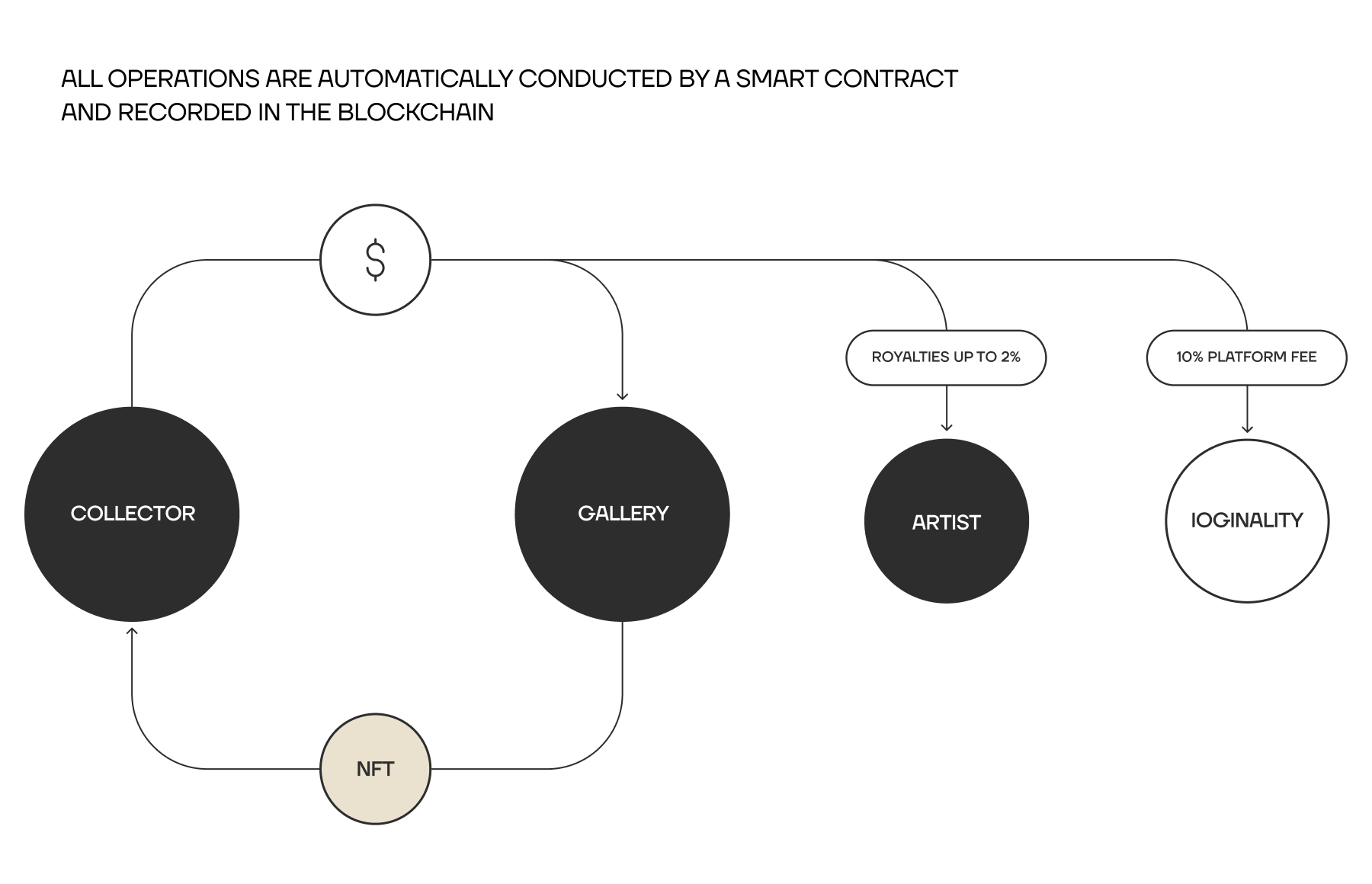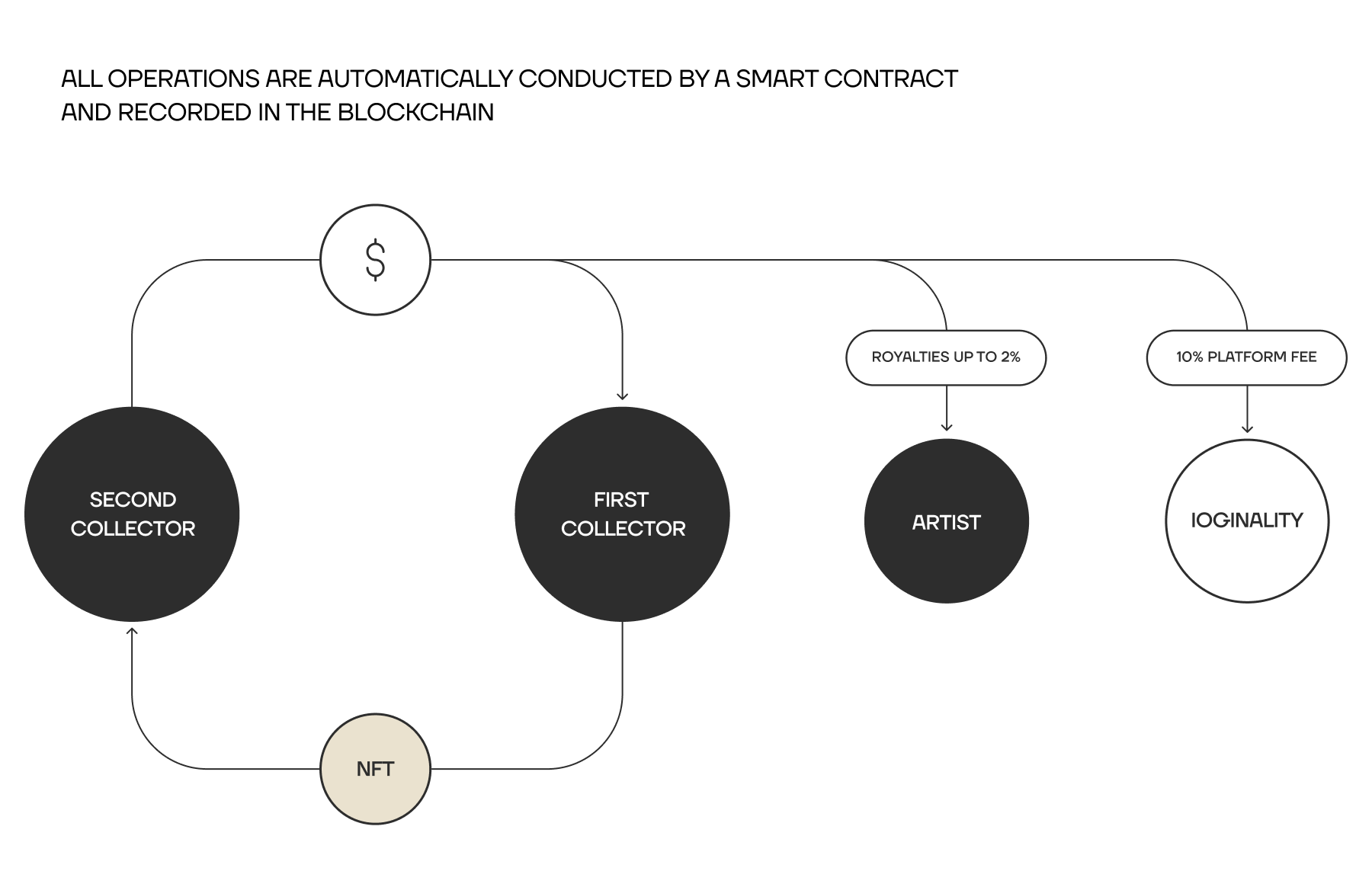Buyer’s and seller’s rights
What rights does the initial buyer have?
When you buy an NFT, think of it as entering into an agreement with the seller, much like buying a unique piece of art with specific terms attached. This agreement, often in the form of a digital contract (not a smart contract, just a regular contract in digital form), spells out the details of your purchase, including what you're allowed to do with the NFT.
The heart of the matter often lies in the contract's fine print. It might grant you certain rights to the digital artwork or content tied to the NFT. However, unless the contract clearly states it, buying the NFT doesn't mean you get intellectual property (IP) rights to the content. In simpler terms: owning the NFT means you have a unique digital item, but it doesn't always mean you can reproduce or profit from the content it represents. Always check the specifics of the agreement.
At IOGINALITY, we've streamlined the NFT transaction process for utmost clarity and ease. When you buy an NFT on our platform, the associated contracts and intellectual property (IP) rights licenses are seamlessly integrated into the tokens themselves. As you proceed with a purchase, a concise summary of the main terms is displayed, ensuring you're always informed about what you're acquiring and the rights that come with it.
For galleries and dealers, our platform offers a versatile set of templates. While these are comprehensive and address all NFT-related concerns, they're also customizable to fit specific needs. This means you can tailor them without the fear of overlooking crucial details, ensuring every transaction is transparent, secure, and in line with your requirements.
Is there a contract between the initial primary buyer and the secondary buyers?
When you buy an NFT, you enter into an agreement with the seller. This agreement outlines the terms of your purchase and the rights associated with the NFT. Once this sale is complete, the original seller steps out of the picture, and you, the new owner, have full control over the NFT.
Now, if you decide to sell this NFT to someone else, the original seller doesn't have a say in this new transaction. This is because of a legal principle called "privity of contract." In simple terms, it means that only the people directly involved in a contract can claim rights or face obligations from it. So, if you sell your NFT to a third person, the original seller can't enforce the first agreement's terms on this new buyer. The initial agreement was between you and the original seller, and it doesn't bind anyone else who wasn't a part of it.
Does it mean the secondary buyer does not have the same rights as the initial buyer?
When you purchase an NFT directly from its original seller, you're granted specific rights as detailed in your purchase agreement. This could encompass ownership of the token, the right to display it, and perhaps certain usage rights related to the digital content it represents.
However, the landscape shifts if you decide to sell this NFT to another party. While the new buyer will indeed own the NFT, they might not automatically inherit all the rights you initially had. For instance, owning the NFT linked to a digital artwork doesn't always grant the rights to reproduce or commercially use the artwork, unless there's a separate agreement in place.
At IOGINALITY, we've recognized these complexities and designed solutions to address them. Our platform's Terms of Service and IP-packages ensure that both primary and subsequent buyers are crystal clear about the rights they're acquiring. Every transaction is transparent, and rights remain consistent across the board. We encourage all users to familiarize themselves with our Terms of Service upon registration to stay informed.
Furthermore, our innovative approach of embedding IP licenses directly into the NFT ensures these rights are retained and protected, even during resale. This integration offers both buyers and sellers an added layer of confidence and security, enhancing the overall experience on the IOGINALITY platform.
How do NFT royalties work, and how do they impact creators and artists?
NFT royalties are a game-changer for creators and artists, introducing a new revenue stream that wasn't prevalent in traditional art sales. Here's how they function:
When an artist or creator mints an NFT, they can set a royalty percentage. This percentage represents the share they'll receive from any future sales of that NFT on secondary markets. For instance, if an artist sets a 10% royalty and the NFT is later resold for $1,000, the artist would automatically receive $100 from that sale.
The beauty of this system lies in its automation. Thanks to the underlying smart contract technology, these royalties are automatically routed to the creator's digital wallet every time the NFT changes hands. There's no need for intermediaries, manual tracking, or additional paperwork.
Impact on Creators and Artists:
- Sustained Revenue: Unlike traditional art sales, where artists benefit only from the initial sale, NFT royalties also ensure they earn from subsequent sales. This can lead to a consistent revenue stream, especially if the value of their work appreciates over time.
- Recognition of Originality: Royalties continuously acknowledge the original creator's contribution, no matter how many times the NFT is resold.
- Incentive to Create: Knowing that they can benefit from future resales motivates artists to produce more and invest in their craft.
- Economic Empowerment: For many artists, especially those in the digital realm, NFT royalties offer a new avenue for financial stability and recognition.
In essence, NFT royalties have revolutionized the way creators are compensated, ensuring they benefit from their work's long-term value and appreciation.

